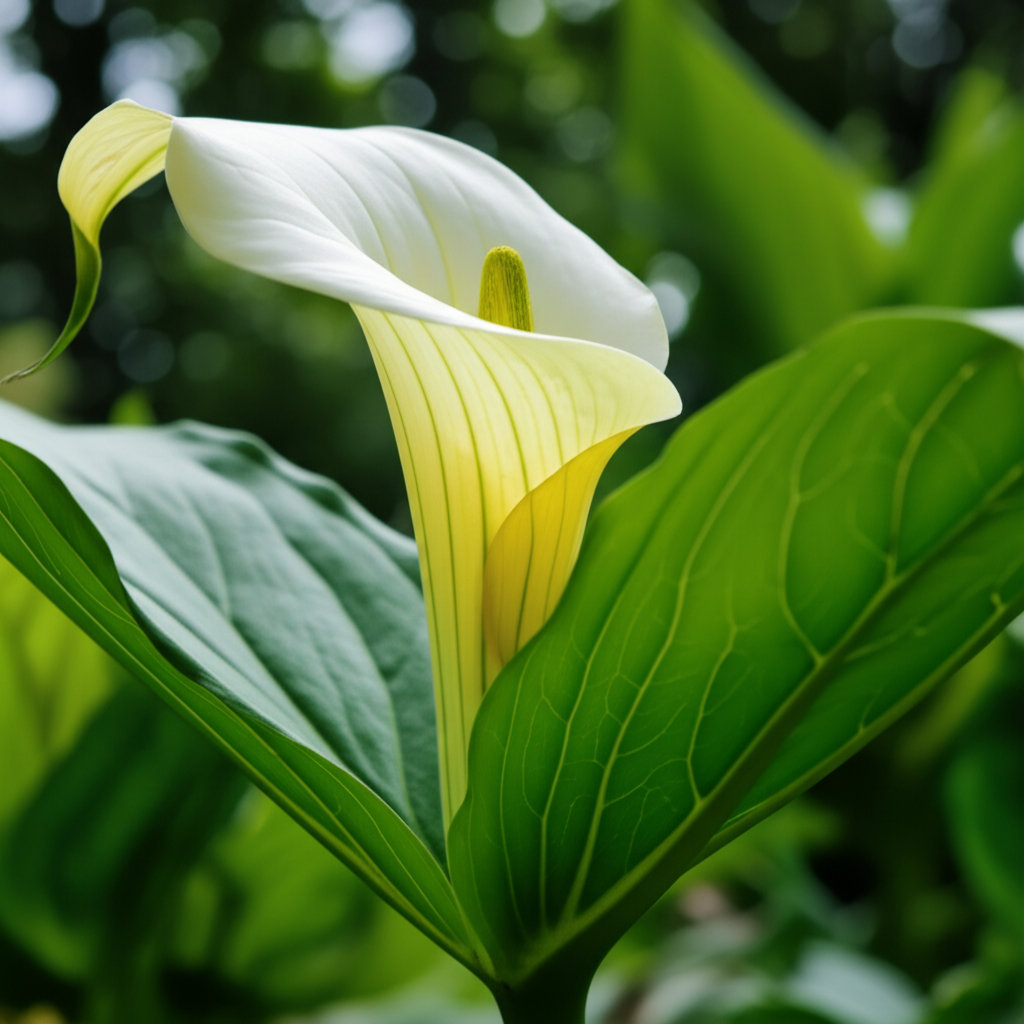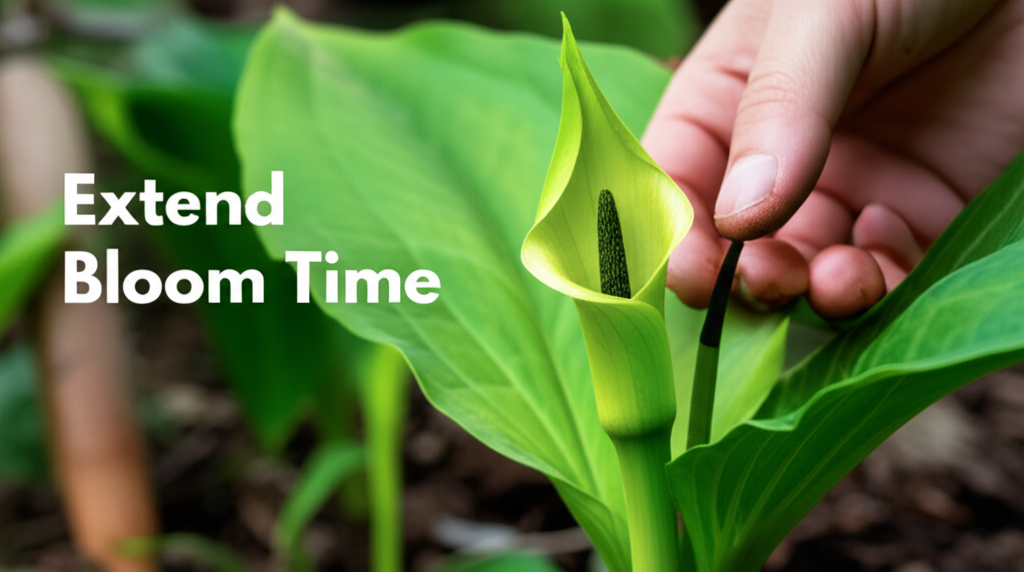Introduction: The Enigmatic Bloom of Jack-in-the-Pulpit
The Jack-in-the-Pulpit (Arisaema triphyllum) is a plant that captures the imagination. Its unique, hooded spathe, resembling a preacher in its pulpit, emerges from the forest floor in early to mid-spring, creating a captivating visual spectacle. However, for many enthusiasts and gardeners, the fleeting nature of this bloom is a point of disappointment. This article delves into the fascinating world of extending the flowering season of the Jack-in-the-Pulpit, exploring techniques that can coax these elusive plants into gracing us with their presence for longer periods. We will examine the plant’s natural life cycle, understand the environmental factors influencing its bloom, and uncover practical methods for maximizing its ornamental value.
Understanding the Natural Flowering Cycle
Before we can manipulate the flowering season, it’s crucial to understand the plant’s natural rhythm. Jack-in-the-Pulpit is a woodland perennial that thrives in moist, shady environments. Its flowering period is typically short, usually lasting only a few weeks in spring. This brevity is a significant part of its charm, making its appearance all the more special. The plant emerges from a corm, and the flowering structure develops shortly after the leaves unfurl. After flowering, the plant focuses its energy on producing berries, which are a vibrant red and a food source for wildlife, before the foliage dies back in late summer. This cycle is strongly influenced by temperature, moisture, and light availability.
Factors Influencing Jack-in-the-Pulpit Flowering

Several key factors dictate when and for how long a Jack-in-the-Pulpit will bloom:
- Temperature: Spring temperatures are the primary trigger for emergence and flowering. Consistent warmth following a sufficient chilling period is essential.
- Moisture: These plants are moisture-loving. Adequate soil moisture is critical for both the development of the flowering structure and its longevity. Drought stress can lead to premature wilting.
- Light: While typically found in shade, the amount of dappled sunlight can influence the timing and vigor of the bloom. Too much direct sun can scorch the delicate spathe, while deep shade might delay emergence.
- Soil Health: Rich, organic soil provides the nutrients necessary for robust growth and flowering.
- Plant Age and Vigor: Older, well-established corms are more likely to produce strong, consistent blooms.
Key Facts and Comparison of Jack-in-the-Pulpit Varieties
While Arisaema triphyllum is the most common species, other related Arisaema species exist with varying flowering times and characteristics. Understanding these differences can inform extension strategies.
| Characteristic | Typical Arisaema triphyllum | Early Blooming Relatives (e.g., some Japanese species) | Late Blooming Relatives (e.g., some Asian species) |
|---|---|---|---|
| Emergence Time | Early to Mid-Spring | Late Winter to Early Spring | Late Spring to Early Summer |
| Flowering Duration | 2-4 weeks | 3-5 weeks | 3-4 weeks |
| Size | Medium (1-3 feet) | Variable, often smaller | Variable, can be larger |
| Habitat Preference | Moist woodlands, stream banks | Variable, often well-drained soils | Variable, often richer soils |
| Spathe Color | Green, brown, purplish | Often more varied and striking | Often more varied and striking |
Techniques for Extending the Flowering Season
Extending the natural flowering period of Jack-in-the-Pulpit is a delicate art, as we are working with a plant that has a specific ecological niche. The goal is not to force unnaturally long blooms, but rather to create conditions that allow existing blooms to last longer and potentially encourage a slightly later flush.
1. Microclimate Manipulation
Creating a more favorable microclimate is perhaps the most effective way to influence the flowering duration. This involves carefully controlling the immediate environment around the plant.
Shade Management
Jack-in-the-Pulpit thrives in dappled shade. Overly sunny conditions can cause the spathe to dry out and fade prematurely. Conversely, extremely deep shade might delay emergence.
- Strategic Planting: Position plants where they receive morning sun and afternoon shade, or filtered light throughout the day.
- Temporary Shade: During prolonged periods of intense sun, consider using shade cloth or strategically placed ephemeral plants that will naturally provide cover.
- Mulching: A thick layer of organic mulch helps retain soil moisture and keeps the roots cool, mitigating the effects of heat stress.
Moisture Regulation
Consistent moisture is paramount. Dehydration is a primary cause of shortened bloom times.
- Watering Schedule: Water deeply and regularly, especially during dry spells. Aim for consistently moist, but not waterlogged, soil.
- Site Selection: Prioritize planting in areas that naturally retain moisture, such as near stream banks, north-facing slopes, or in established woodland gardens.
- Amendments: Incorporate compost and other organic matter into the soil to improve its water-holding capacity.
2. Planting Strategies for Extended Bloom
A staggered planting approach can create a longer overall display of Jack-in-the-Pulpit blooms across the landscape.
- Varietal Selection: If possible, source different varieties or species of Arisaema that have naturally overlapping or sequential flowering times.
- Planting Depths: While not a guaranteed method, some anecdotal evidence suggests that planting corms at slightly different depths might influence emergence times, although this is less reliable for extending an individual bloom.
- Companion Planting: Pair Jack-in-the-Pulpit with other spring ephemerals that have slightly different bloom times. For example, planting with species that bloom slightly earlier can provide a visual prelude, while those that bloom slightly later can extend the woodland garden’s interest.
3. Soil and Nutrition
A healthy plant is a long-lasting plant. Providing optimal soil conditions supports robust flowering.
- Rich Organic Matter: Jack-in-the-Pulpit prefers humus-rich, well-drained soil. Amend planting sites with compost, leaf mold, or aged manure.
- Fertilization (Use with Caution): While not heavy feeders, a light application of a balanced, slow-release organic fertilizer in early spring can support healthy growth and flowering. Avoid over-fertilizing, which can lead to leggy growth and potentially reduce bloom longevity.
4. Managing Pests and Diseases
Healthy plants are less susceptible to stress that can shorten flowering.
- Observation: Regularly inspect plants for signs of pests or diseases.
- Integrated Pest Management: Address any issues promptly using organic methods where possible. Slugs and snails can damage the spathe, so protective measures may be necessary.
Pros and Cons of Flowering Season Extension Techniques
Implementing these techniques comes with its own set of advantages and disadvantages. Careful consideration is needed to determine the best approach for your specific situation.
| Technique | Pros | Cons |
|---|---|---|
| Microclimate Manipulation (Shade/Moisture) | Most effective for extending individual blooms; mimics natural conditions; enhances plant health. | Requires careful observation and site assessment; can be labor-intensive in extreme conditions. |
| Strategic Planting (Varieties/Depths) | Creates a longer overall visual display; leverages natural differences in species. | Requires access to diverse varieties; planting depth is an uncertain variable. |
| Soil and Nutrition Improvement | Promotes overall plant health and vigor; essential for long-term success. | Requires initial effort in soil preparation; over-fertilization can be detrimental. |
| Pest and Disease Management | Protects the bloom and the plant’s health; prevents premature decline. | Can require vigilance and specific treatments. |
5. Advanced Considerations: Dormancy and Corm Viability
The health of the corm is fundamental to successful flowering. Ensuring the corm has ample resources to store energy after foliage dieback is crucial for the following year’s bloom.
- Post-Bloom Care: After the foliage begins to yellow, allow it to die back naturally. This signals that the plant is preparing for dormancy and transferring energy to the corm. Do not cut back the leaves prematurely.
- Corm Division: Overcrowded corms can compete for resources, leading to reduced flowering. Periodically, every few years, consider gently dividing clumps of Jack-in-the-Pulpit corms when they are dormant (late summer to early fall) to ensure each plant has adequate space and nutrients. This can lead to stronger blooms in subsequent years.
Conclusion: The Rewarding Effort of Extending the Spectacle
Extending the flowering season of the Jack-in-the-Pulpit is less about forcing an unnatural bloom and more about understanding and supporting its natural life cycle. By carefully managing microclimates, ensuring adequate moisture and nutrition, and employing thoughtful planting strategies, gardeners can enjoy the captivating presence of these woodland wonders for a slightly longer period each spring. While the bloom itself is ephemeral, the techniques employed to nurture and prolong its display are a testament to the dedication of plant enthusiasts and a deeper appreciation for the subtle beauty of native flora. The reward is not just a longer flowering period, but a healthier, more vibrant population of these enchanting plants for seasons to come.


